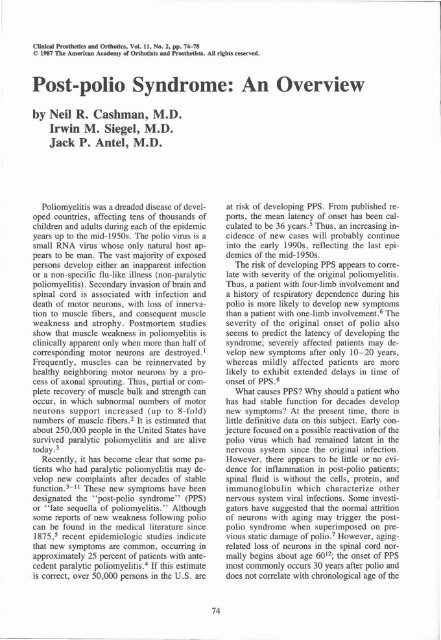View Complete Issue PDF
View Complete Issue PDF
View Complete Issue PDF
Create successful ePaper yourself
Turn your PDF publications into a flip-book with our unique Google optimized e-Paper software.
Post-polio Syndrome: An Overview<br />
by Neil R. Cashman, M.D.<br />
Irwin M. Siegel, M.D.<br />
Jack P. Antel, M.D.<br />
Poliomyelitis was a dreaded disease of developed<br />
countries, affecting tens of thousands of<br />
children and adults during each of the epidemic<br />
years up to the mid-1950s. The polio virus is a<br />
small RNA virus whose only natural host appears<br />
to be man. The vast majority of exposed<br />
persons develop either an inapparent infection<br />
or a non-specific flu-like illness (non-paralytic<br />
poliomyelitis). Secondary invasion of brain and<br />
spinal cord is associated with infection and<br />
death of motor neurons, with loss of innervation<br />
to muscle fibers, and consequent muscle<br />
weakness and atrophy. Postmortem studies<br />
show that muscle weakness in poliomyelitis is<br />
clinically apparent only when more than half of<br />
corresponding motor neurons are destroyed. 1<br />
Frequently, muscles can be reinnervated by<br />
healthy neighboring motor neurons by a process<br />
of axonal sprouting. Thus, partial or complete<br />
recovery of muscle bulk and strength can<br />
occur, in which subnormal numbers of motor<br />
neurons support increased (up to 8-fold)<br />
numbers of muscle fibers. 2<br />
It is estimated that<br />
about 250,000 people in the United States have<br />
survived paralytic poliomyelitis and are alive<br />
today. 3<br />
Recently, it has become clear that some patients<br />
who had paralytic poliomyelitis may develop<br />
new complaints after decades of stable<br />
function. 3-11<br />
These new symptoms have been<br />
designated the "post-polio syndrome" (PPS)<br />
or "late sequella of poliomyelitis." Although<br />
some reports of new weakness following polio<br />
can be found in the medical literature since<br />
1875, 5 recent epidemiologic studies indicate<br />
that new symptoms are common, occurring in<br />
approximately 25 percent of patients with antecedent<br />
paralytic poliomyelitis. 4<br />
If this estimate<br />
is correct, over 50,000 persons in the U.S. are<br />
at risk of developing PPS. From published reports,<br />
the mean latency of onset has been calculated<br />
to be 36 years. 5<br />
Thus, an increasing incidence<br />
of new cases will probably continue<br />
into the early 1990s, reflecting the last epidemics<br />
of the mid-1950s.<br />
The risk of developing PPS appears to correlate<br />
with severity of the original poliomyelitis.<br />
Thus, a patient with four-limb involvement and<br />
a history of respiratory dependence during his<br />
polio is more likely to develop new symptoms<br />
than a patient with one-limb involvement. 6<br />
The<br />
severity of the original onset of polio also<br />
seems to predict the latency of developing the<br />
syndrome; severely affected patients may develop<br />
new symptoms after only 10-20 years,<br />
whereas mildly affected patients are more<br />
likely to exhibit extended delays in time of<br />
onset of PPS. 6<br />
What causes PPS? Why should a patient who<br />
has had stable function for decades develop<br />
new symptoms? At the present time, there is<br />
little definitive data on this subject. Early conjecture<br />
focused on a possible reactivation of the<br />
polio virus which had remained latent in the<br />
nervous system since the original infection.<br />
However, there appears to be little or no evidence<br />
for inflammation in post-polio patients;<br />
spinal fluid is without the cells, protein, and<br />
immunoglobulin which characterize other<br />
nervous system viral infections. Some investigators<br />
have suggested that the normal attrition<br />
of neurons with aging may trigger the postpolio<br />
syndrome when superimposed on previous<br />
static damage of polio. 7<br />
However, agingrelated<br />
loss of neurons in the spinal cord normally<br />
begins about age 60 12 ; the onset of PPS<br />
most commonly occurs 30 years after polio and<br />
does not correlate with chronological age of the

















